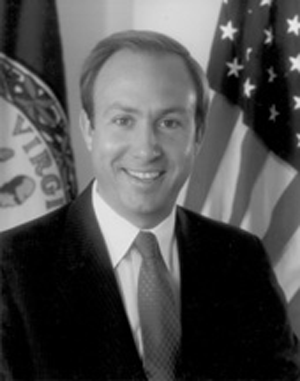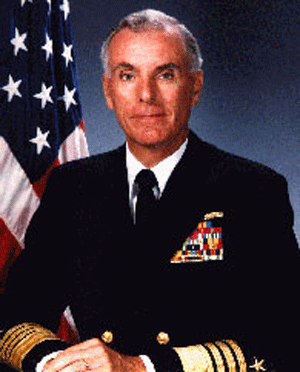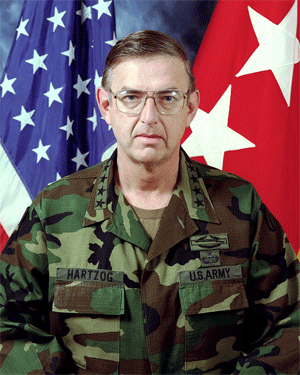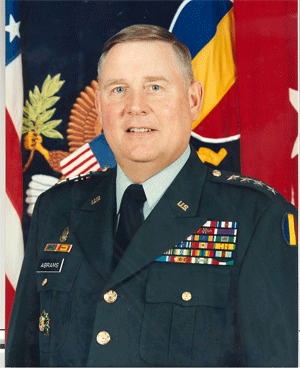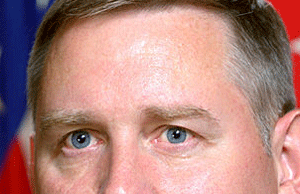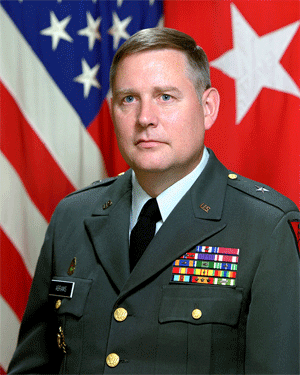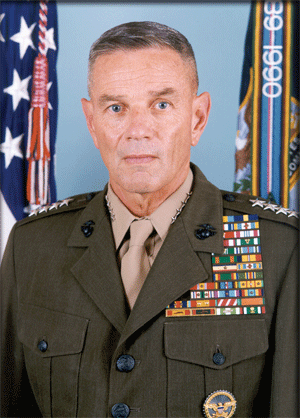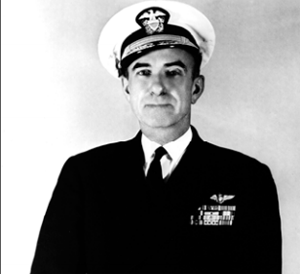Carl Epting Mundy Jr.by Wikipedia
Accessed: 12/16/17
NOTICE: THIS WORK MAY BE PROTECTED BY COPYRIGHTYOU ARE REQUIRED TO READ
THE COPYRIGHT NOTICE AT THIS LINK BEFORE YOU READ THE FOLLOWING WORK, THAT IS AVAILABLE SOLELY FOR PRIVATE STUDY, SCHOLARSHIP OR RESEARCH PURSUANT TO 17 U.S.C. SECTION 107 AND 108. IN THE EVENT THAT THE LIBRARY DETERMINES THAT UNLAWFUL COPYING OF THIS WORK HAS OCCURRED, THE LIBRARY HAS THE RIGHT TO BLOCK THE I.P. ADDRESS AT WHICH THE UNLAWFUL COPYING APPEARED TO HAVE OCCURRED. THANK YOU FOR RESPECTING THE RIGHTS OF COPYRIGHT OWNERS.
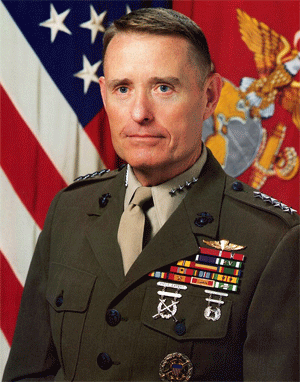

Carl E. Mundy Jr.
30th Commandant of the Marine Corps (1991-1995)
Birth name Carl Epting Mundy Jr.
Born July 16, 1935
Atlanta, Georgia, U.S.
Died April 2, 2014 (aged 78)
Alexandria, Virginia, U.S.
Allegiance United States of America
Service/branch United States Marine Corps
Years of service 1953-1995
Rank US Marine 10 shoulderboard.svg General
Commands held 2nd Battalion, 4th Marines
2nd Marine Regiment
4th Marine Amphibious Brigade
II Marine Expeditionary Force
Marine Forces Atlantic
Commandant of the Marine Corps
Battles/wars Vietnam War
Cold War
Awards Defense Distinguished Service Medal
Navy, Army, Air Force, & Coast Guard Distinguished Service Medals
Legion of Merit
Bronze Star
Purple Heart
Other work USO
Marine Corps University Foundation
Schering-Plough
General Dynamics
Council on Foreign Relations
Carl Epting Mundy Jr. (July 16, 1935 – April 2, 2014) was a United States Marine Corps General who was the 30th Commandant of the United States Marine Corps and member of the Joint Chiefs of Staff from July 1, 1991 until his retirement on June 30, 1995, after 38 years of active duty service.
From 1996 to 2000, he served as president and CEO of the USO.[1] Mundy was the chairman of the Marine Corps University Foundation.[2] He also served on a number of corporate boards.
Early life and educationMundy was born on July 16, 1935 in Atlanta, Georgia.[3] His family moved frequently when he was a young child, settling in Waynesville, North Carolina when Mundy was about 10 years old.[3] He graduated from Sidney Lanier High School in Montgomery, Alabama. At age 18, he enlisted in the U.S. Marine Corps Reserve.[4]
Career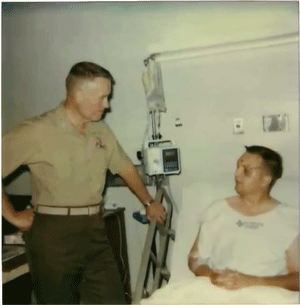 Mundy visiting a survivor of the Oklahoma City bombing in 1995.
Mundy visiting a survivor of the Oklahoma City bombing in 1995.Mundy enlisted in the Marine Corps Reserve and enrolled in the PLC Program in December 1953 while attending college – serving in the 38th Special Infantry Company, Montgomery, Alabama and rising to the rank of sergeant. He was commissioned a Second Lieutenant in June 1957, following graduation from Auburn University. His later military education included the Command and General Staff College and the Naval War College.
His early assignments included service in the 2nd Marine Regiment, 2nd Marine Division; duty aboard the aircraft carrier USS Tarawa (CV-40) and the cruiser USS Little Rock (CLG-4); instructor at The Basic School; and as Officer Selection Officer, Raleigh, North Carolina. In 1966-67, Mundy served in Vietnam as operations and executive officer of the 3rd Battalion, 26th Marines, 3rd Marine Division, and as an intelligence officer in the Headquarters, III Marine Amphibious Force.
After the Vietnam War, his principal assignments were:
Aide de Camp to the Assistant Commandant of the Marine Corps
Inspector Instructor, 4th Air-Naval Gunfire Liaison Company, Miami, Florida
Commanding Officer, 2nd Battalion, 4th Marines, 3rd Marine Division
Plans Officer, Headquarters Marine Corps
Assistant Chief of Staff for Intelligence, 2nd Marine Division
Chief of Staff, Sixth Marine Amphibious Brigade
Commanding Officer, 2nd Marine Regiment, 2nd Marine Division, and 36th and 38th Marine Amphibious Units
Following advancement to Brigadier General in April 1982, Mundy's assignments were:
Director of Personnel Procurement, Headquarters Marine Corps
Commanding General, Landing Force Training Command, U.S. Atlantic Fleet, and Commanding General, 4th Marine Amphibious Brigade
Advanced to major general in April 1986
Director of Operations, Plans, Policies and Operations Department, Headquarters Marine Corps
Advanced to lieutenant general in March 1988
Deputy Chief Staff for Plans, Policies and Operations, Headquarters Marine Corps Operations Deputy to the Joint Chiefs of Staff
Commanding General of the Fleet Marine Force, Atlantic, the II Marine Expeditionary Force, the Allied Command Atlantic Marine Striking Force, and designated to command Fleet Marine Forces which might be employed in Europe
Promoted to General on July 1, 1991
Commandant of the Marine Corps from July 1, 1991 to June 30, 1995
Awards and decorationsGeneral Mundy's awards include:
Marine Corps Parachutist badge
1st Row Defense Distinguished Service Medal Office of the Joint Chiefs of Staff Identification Badge
2nd Row Navy Distinguished Service Medal Army Distinguished Service Medal Air Force Distinguished Service Medal Coast Guard Distinguished Service Medal
3rd Row Legion of Merit Bronze Star w/ valor device Purple Heart Medal Navy Commendation Medal w/ 1 award star & valor device
4th Row Combat Action Ribbon Navy Presidential Unit Citation Navy Unit Commendation National Defense Service Medal w/ 1 service star
5th Row Armed Forces Expeditionary Medal Vietnam Service Medal w/ 2 service stars Sea Service Ribbon Vietnamese Cross of Gallantry w/ 1 gold star
6th Row Colombian Distinguished Service[clarification needed] Spanish White Cross of Naval Merit French Legion of Honor, Grade of Commander Argentinian Order of the Liberator General San Martin, Grand Cross
7th Row Royal Norwegian Order of Merit, Grand Cross Netherlands Medal of Merit in silver Vietnamese Cross of Gallantry Unit Citation Vietnam Campaign Medal
Note: The gold US Navy Parachute Rigger badge was worn unofficially by USMC personnel in place of US Army parachutist badge from 1942-1963 before it officially became the Navy and Marine Corps Parachutist insignia on July 12, 1963 per BuPers Notice 1020. Members of the Marine Corps who attended jump school before 1963 were issued the silver Army parachutist badge but may be depicted wearing the gold Navy Parachute Rigger badge as it was common practice during this time period.
Personal life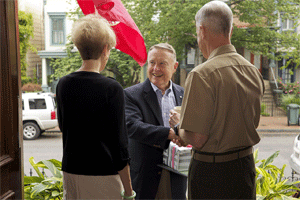 Mundy in May 2013
Mundy in May 2013Mundy was married and has three children – two sons and a daughter. Both sons are U.S. Marine Corps officers, including Carl Epting Mundy III, who is a major general.[5][6]
Remarks on minority officersIn an October 31, 1993 segment on the CBS program 60 Minutes on the dearth of minority promotions in the U.S. Marine Corps, General Mundy was quoted as saying, "In the military skills, we find that the minority officers do not shoot as well as the non-minorities. They don't swim as well. And when you give them a compass and send them across the terrain at night in a land navigation exercise, they don't do as well at that sort of thing."[7] Mundy, noted for being blunt, though possibly the "victim of selective editing", apologized for "any offense that may have been taken" from his remarks.[8] According to The Times, the general elaborated on this question at a 1993 commemoration of the Battle of Iwo Jima, when commenting on Ira Hayes, he said "Were Ira Hayes here today ... I would tell him that although my words on another occasion have given the impression that I believe some Marines ... because of their color ... are not as capable as other Marines ... that those were not the thoughts of my mind ... and that they are not the thoughts of my heart.[9][10]
Position on married MarinesMundy issued an order in 1993 to cut down (and eventually eliminate) the recruitment category for married Marines; the order was rescinded following a public outcry.
Remarks on gays serving in the militaryMundy was signatory to an open letter delivered to President Barack Obama and Members of Congress expressing support for the 1993 law stating that self-identified homosexuals are not eligible to serve in the military, commonly referred to as "Don't ask, don't tell."[11] The letter said in part, "We believe that imposing this burden on our men and women in uniform would undermine recruiting and retention, impact leadership at all echelons, have adverse effects on the willingness of parents who lend their sons and daughters to military service, and eventually break the All-Volunteer Force."[12] However unlike the 34th commandant, General James T. Conway, Mundy has said that if the restriction were repealed the troops should not be segregated.[13][14] For a person to "proclaim: I'm gay" is the "same as I'm KKK, Nazi, rapist," Mundy says.[15]
DeathMundy died of cancer (Merkel cell carcinoma) at his home in Alexandria, Virginia on April 2, 2014 at the age of 78.[16][17]
Notes1. "Carl Mundy: Executive Profile & Biography". Business Week. Retrieved 22 February 2009.
2. "Board of Trustees: General Carl E. Mundy Jr. USMC (Ret) – Chairman". Marine Corps University Foundation. Archived from the original on 25 August 2009. Retrieved 22 February 2009.
3. b Ruane, Michael E. (June 5, 1999). "Four Years Ago, Carl Mundy Hung Up His Sword. His Life Would Never Be the Same" (Reprinted on
http://www.patriotfiles.com). Washington Post. p. C01. Retrieved 22 February 2009.
4. "2007 Lifetime Achievement Award Recipients: Carl E. Mundy Jr. '57". Auburn University. Archived from the original on 25 August 2009. Retrieved 22 February2009.
5. "Major General Carl E. Mundy, III Commander, Task Force 51". U.S. Navy. Archived from the original on 20 January 2015. Retrieved 20 January 2015.
6. "Archived copy". Archived from the original on 2012-04-01. Retrieved 2011-10-18.
7. "A Few Good Men". 60 Minutes. CBS News. 2 June 1999.
8. "Apology for Remarks On Minority Marines". New York Times. November 3, 1993.
9. Thompson, Mark (28 November 1993). "Commandant Of Marine Corps Doesn't Mince Words – Mundy's Comments: Wonderfully Blunt Or Just Insensitive?". Seattle Times. Retrieved 22 February 2009.
10. Asthana, Anushka; Ford, Richard; Watson, Roland. "The Times". London. Archived from the original on 2013-05-05.
11. "Homosexuals in the Military" Archived 2009-07-20 at the Wayback Machine., Center for Military Readiness, April 9, 2009.
12. "Flag and General Officers for the Military" Archived 2009-04-23 at the Wayback Machine., April 9, 2009.
13. Marines will still be 'hammering' Afghanistan next year Archived 2010-08-27 at the Wayback Machine.
14. "What Would It Take To End 'Don't Ask, Don't Tell'?". NPR.org. 5 February 2010. Retrieved 27 April 2016.
15. Eric Bradner, CNN (10 October 2014). "Clinton presidential documents cover Kagan, gays, email - CNNPolitics.com". CNN. Retrieved 27 April 2016.
16. "Archived copy". Archived from the original on 2014-07-17. Retrieved 2014-04-03.
17. "Archived copy". Archived from the original on 2014-04-06. Retrieved 2014-04-03.
References• "Official Biography: General Carl E. Mundy Jr". United States Marine Corps. Archived from the original on 20 February 2012. Retrieved 9 April 2014.
Further reading• Mundy, General Carl E. Jr. (November 1, 1993). "The Role of the Marine Corps in the Post-Cold War Era". Heritage Lecture #475. Heritage Foundation. Archived from the original on 19 February 2009. Retrieved 22 February 2009.
